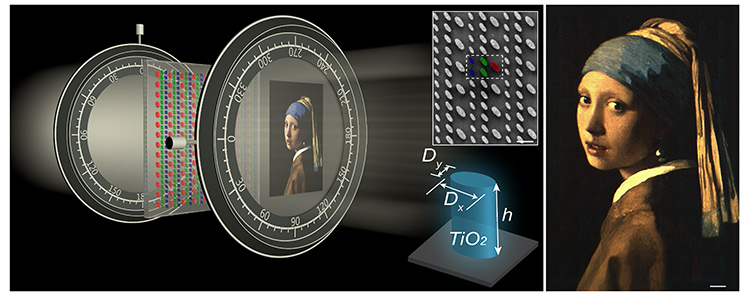 Left: Schematic for generating a full-color nanopainting. Insets: Illustration of a constituent nanopillar (bottom) and SEM image of fabricated TiO2 nanopillars (top). False-color shading indicates the primary colors generated by the nanopillars. Scale bar: 500 nm. Right: Experimental color image generated by passing white light through polarizer, metasurface and analyzer. Scale bar: 50 μm
Left: Schematic for generating a full-color nanopainting. Insets: Illustration of a constituent nanopillar (bottom) and SEM image of fabricated TiO2 nanopillars (top). False-color shading indicates the primary colors generated by the nanopillars. Scale bar: 500 nm. Right: Experimental color image generated by passing white light through polarizer, metasurface and analyzer. Scale bar: 50 μm
Color, which results from resonant interaction of light with discrete energy states of atoms and molecules, is a primary attribute of human visual perception. It plays a crucial role both in imaging and display technology and in the arts. In work this year, we demonstrated the ability to tune both color hue and brightness in transmitted light with a specially designed metasurface—at a level of detail sufficient to create a “nanopainting” that reproduces a celebrated artwork.1
Remarkable developments in nanofabrication technology in recent years have created the ability to engineer the interaction of light with artificial nanostructures, “meta-atoms” and “meta-molecules,” on a deep-subwavelength scale, to create vivid structural colors.2 These artificial nanostructures—composed either of metals that leverage localized surface plasmon resonances, or of dielectric materials that leverage Mie resonances—can tailor the spectrum of incoming light, and generate vivid colors by simply varying their shape, size or material composition.
Most work in this area of color engineering using nanostructured surfaces has focused on achieving high color gamut and saturation, while preserving the amplitude of the desired color upon transmission or reflection. Though such devices exhibit high transmission or reflection efficiency, the brightness of the generated color is fixed. However, since brightness is (along with gamut and saturation) one of the fundamental properties of color, the ability to convey impressions of perspective, depth and even three-dimensionality requires efficient and smooth tuning of the brightness as well as hue.
In our work,1 we demonstrated the ability to efficiently and smoothly control the brightness of structural colors across the entire visible spectral range through the realization of a nanopainting—a millimeter-scale image displaying subtle color and shadow details as if created with a nanoscale brush. We implemented a reproduction of the 1665 masterpiece by Dutch artist Johannes Vermeer, Girl with a Pearl Earring, using a low-loss dielectric-metasurface. The surface included an array of titanium-dioxide nanopillars of spatially varying dimensions, which determine the hue of the output color, and rotational orientations, which determine its brightness.
The nanopillars are designed to act individually as narrowband half-wave plates capable of rotating the polarization of linearly polarized incident light only for the targeted filtering colors—red, green and blue. The metasurface-generated image, under white-light illumination and orthogonal polarizer–analyzer orientation, reveals a faithful, high-resolution replica of the painting, displaying its iconic subject wearing a blue turban, gold jacket, bright white collar and glowing pearl earring.
The scene is bathed in directional light, with dramatic peripheral shadows merging seamlessly into the black background. The remarkably smooth hue and brightness transitions confer an oil-painting-like appearance to the reproduction—illustrating how nanotechnology can meet Vermeer’s masterful rendering of color, light and shadow
Researchers
Pengcheng Huo, Maowen Song, Yanqing Lu and Ting Xu, Nanjing University, Nanjing, China
Wenqi Zhu, Henri J. Lezec and Amit Agrawal, National Institute of Standards and Technology, Gaithersburg, MD, USA
Motoko Shimizu, Freer Gallery of Art and Arthur M. Sackler Gallery, Smithsonian Institution, Washington, DC, USA
References
1. P. Huo et al. Optica 7, 1171 (2020).
2. S.D. Rezaei et al. ACS Photon., doi: 10.1021/acsphotonics.0c00947 (2020).

